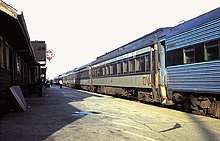Maple Leaf (GTW train)
The Maple Leaf was a passenger train pool operated by the Canadian National and the Grand Trunk Western Railroad ("Grand Trunk") between Chicago, Illinois and Toronto, Ontario. It operated from 1927 to 1971. The train took its name from the maple leaf, the national symbol of Canada. The Maple Leaf was one of many trains discontinued when Amtrak began operations in 1971, and is unrelated to the Maple Leaf which Amtrak now operates between Toronto and New York City. The train operated on Canadian National railroad territory through Ontario, but west of Lake Huron it operated via Grand Trunk Railroad.
.jpg) GTW GP9 4912 with The Maple Leaf, Valparaiso, IN on February 21, 1971 | |
| Overview | |
|---|---|
| Service type | Inter-city rail, Daytime |
| Status | Discontinued |
| Locale | Midwestern United States/Southern Ontario |
| First service | May 15, 1927 |
| Last service | April 30, 1971 |
| Former operator(s) | Grand Trunk Western Railroad, Canadian National |
| Route | |
| Start | Chicago, Illinois |
| Stops |
|
| End | Toronto, Ontario |
| Average journey time |
|
| Service frequency | Daily |
| Train number(s) |
|
| On-board services | |
| Class(es) | Coach Class |
| Seating arrangements | Club Car seats |
| Catering facilities | Meal |
| Observation facilities | Lounge car |
| Technical | |
| Track gauge | 1,435 mm (4 ft 8 1⁄2 in) |
| Operating speed |
|
History

The Grand Trunk introduced the Maple Leaf on May 15, 1927. The train operated on an overnight schedule between Chicago and Montreal, Quebec. In 1932 it began carrying a through sleeper for New York. In May 1937 the Grand Trunk renamed the westbound Maple Leaf the La Salle. The eastbound Maple Leaf was known as the New York Maple Leaf between 1938 and 1939. The name Toronto Maple Leaf was briefly applied to a Chicago–Port Huron, Michigan train in 1938.[1]:189 In 1938 the New York Maple Leaf was one of several Grand Trunk trains to receive Class U-4-b 4-8-4 steam locomotives built by the Lima Locomotive Works.[2]
The Maple Leaf operated on a daytime schedule between Chicago and Toronto in the 1950s. It carried a Chicago–Montreal through sleeper, a Chicago–Detroit through coach, a Port Huron–Toronto cafe/parlor car, parlor cars, and coaches. A dining car operated between Chicago and Lansing, Michigan.[3] The Montreal sleeper ended in 1958.[1]:191 By 1956 the main part of the route circumvented Detroit and went through Port Huron, and served Detroit via a spur branch from London, Ontario. [4]
In 1966 the Grand Trunk renamed the westbound Inter-City Limited the Maple Leaf, thus making the Maple Leaf a daytime round-trip between Chicago and Toronto. [1] :191 After the truncation of the International Limited to Port Huron on June 23, 1970, the Maple Leaf was the Grand Trunk train on the Chicago–Toronto route. Amtrak discontinued all remaining Grand Trunk trains when it began operations in 1971. Service over the Grand Trunk resumed on September 15, 1974, with the introduction of the Blue Water Limited.[5]:203–204
References
- Sanders, Craig (2003). Limiteds, Locals, and Expresses in Indiana, 1838–1971. Bloomington, Indiana: Indiana University Press. ISBN 978-0-253-34216-4.
- "New G.T.W. Engine Placed in Service". Argus-Press. August 12, 1938.
- Grand Trunk Railway System (September 25, 1955). "Lines in Michigan, Indiana, Illinois".
- 1956 Canadian National railway timetable http://streamlinermemories.info/CAN/CN56-9TT.pdf
- Sanders, Craig (2006). Amtrak in the Heartland. Bloomington, Indiana: Indiana University Press. ISBN 978-0-253-34705-3.